Las Iguanas Case Study: Employer Branding, Recruitment and Retention
VerifiedAdded on 2023/04/22
|7
|2785
|359
Report
AI Summary
This report examines the employer branding strategies of the restaurant chain Las Iguanas, focusing on its impact on recruitment and retention. It highlights the company's past success as an employer of choice, which was tarnished by a controversial "pay to work" policy. The report scrutinizes the link between employer branding and talent management within Las Iguanas, discussing the damages caused by the tipping policy and its effect on recruitment and retention. It also provides recommendations for restoring the brand image, emphasizing the importance of aligning HR practices with marketing strategies and addressing employee dissatisfaction to improve recruitment and retention outcomes. The analysis draws on various sources to assess the effectiveness of Las Iguanas' strategies and the challenges it faces in maintaining a positive employer brand.
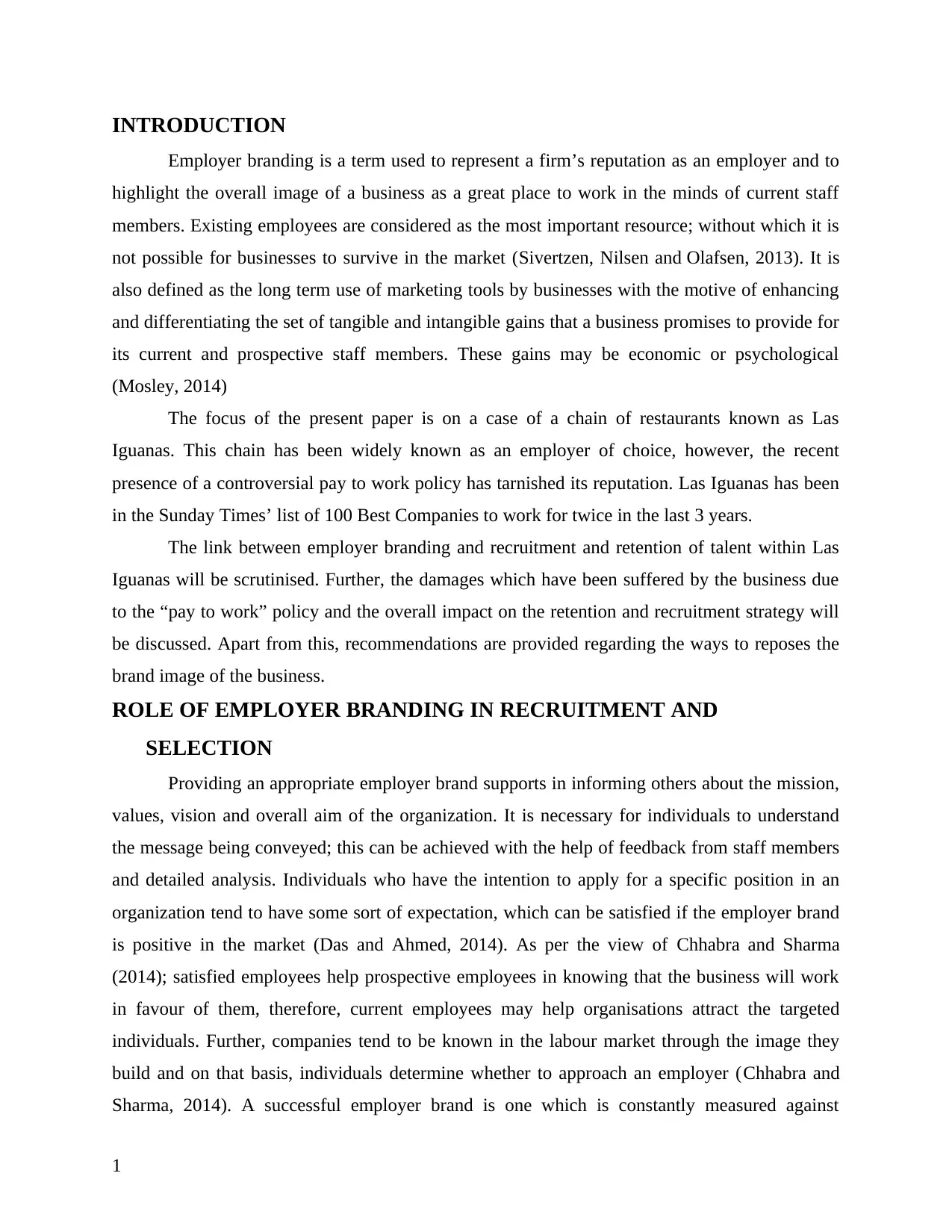
INTRODUCTION
Employer branding is a term used to represent a firm’s reputation as an employer and to
highlight the overall image of a business as a great place to work in the minds of current staff
members. Existing employees are considered as the most important resource; without which it is
not possible for businesses to survive in the market (Sivertzen, Nilsen and Olafsen, 2013). It is
also defined as the long term use of marketing tools by businesses with the motive of enhancing
and differentiating the set of tangible and intangible gains that a business promises to provide for
its current and prospective staff members. These gains may be economic or psychological
(Mosley, 2014)
The focus of the present paper is on a case of a chain of restaurants known as Las
Iguanas. This chain has been widely known as an employer of choice, however, the recent
presence of a controversial pay to work policy has tarnished its reputation. Las Iguanas has been
in the Sunday Times’ list of 100 Best Companies to work for twice in the last 3 years.
The link between employer branding and recruitment and retention of talent within Las
Iguanas will be scrutinised. Further, the damages which have been suffered by the business due
to the “pay to work” policy and the overall impact on the retention and recruitment strategy will
be discussed. Apart from this, recommendations are provided regarding the ways to reposes the
brand image of the business.
ROLE OF EMPLOYER BRANDING IN RECRUITMENT AND
SELECTION
Providing an appropriate employer brand supports in informing others about the mission,
values, vision and overall aim of the organization. It is necessary for individuals to understand
the message being conveyed; this can be achieved with the help of feedback from staff members
and detailed analysis. Individuals who have the intention to apply for a specific position in an
organization tend to have some sort of expectation, which can be satisfied if the employer brand
is positive in the market (Das and Ahmed, 2014). As per the view of Chhabra and Sharma
(2014); satisfied employees help prospective employees in knowing that the business will work
in favour of them, therefore, current employees may help organisations attract the targeted
individuals. Further, companies tend to be known in the labour market through the image they
build and on that basis, individuals determine whether to approach an employer (Chhabra and
Sharma, 2014). A successful employer brand is one which is constantly measured against
1
Employer branding is a term used to represent a firm’s reputation as an employer and to
highlight the overall image of a business as a great place to work in the minds of current staff
members. Existing employees are considered as the most important resource; without which it is
not possible for businesses to survive in the market (Sivertzen, Nilsen and Olafsen, 2013). It is
also defined as the long term use of marketing tools by businesses with the motive of enhancing
and differentiating the set of tangible and intangible gains that a business promises to provide for
its current and prospective staff members. These gains may be economic or psychological
(Mosley, 2014)
The focus of the present paper is on a case of a chain of restaurants known as Las
Iguanas. This chain has been widely known as an employer of choice, however, the recent
presence of a controversial pay to work policy has tarnished its reputation. Las Iguanas has been
in the Sunday Times’ list of 100 Best Companies to work for twice in the last 3 years.
The link between employer branding and recruitment and retention of talent within Las
Iguanas will be scrutinised. Further, the damages which have been suffered by the business due
to the “pay to work” policy and the overall impact on the retention and recruitment strategy will
be discussed. Apart from this, recommendations are provided regarding the ways to reposes the
brand image of the business.
ROLE OF EMPLOYER BRANDING IN RECRUITMENT AND
SELECTION
Providing an appropriate employer brand supports in informing others about the mission,
values, vision and overall aim of the organization. It is necessary for individuals to understand
the message being conveyed; this can be achieved with the help of feedback from staff members
and detailed analysis. Individuals who have the intention to apply for a specific position in an
organization tend to have some sort of expectation, which can be satisfied if the employer brand
is positive in the market (Das and Ahmed, 2014). As per the view of Chhabra and Sharma
(2014); satisfied employees help prospective employees in knowing that the business will work
in favour of them, therefore, current employees may help organisations attract the targeted
individuals. Further, companies tend to be known in the labour market through the image they
build and on that basis, individuals determine whether to approach an employer (Chhabra and
Sharma, 2014). A successful employer brand is one which is constantly measured against
1
Paraphrase This Document
Need a fresh take? Get an instant paraphrase of this document with our AI Paraphraser
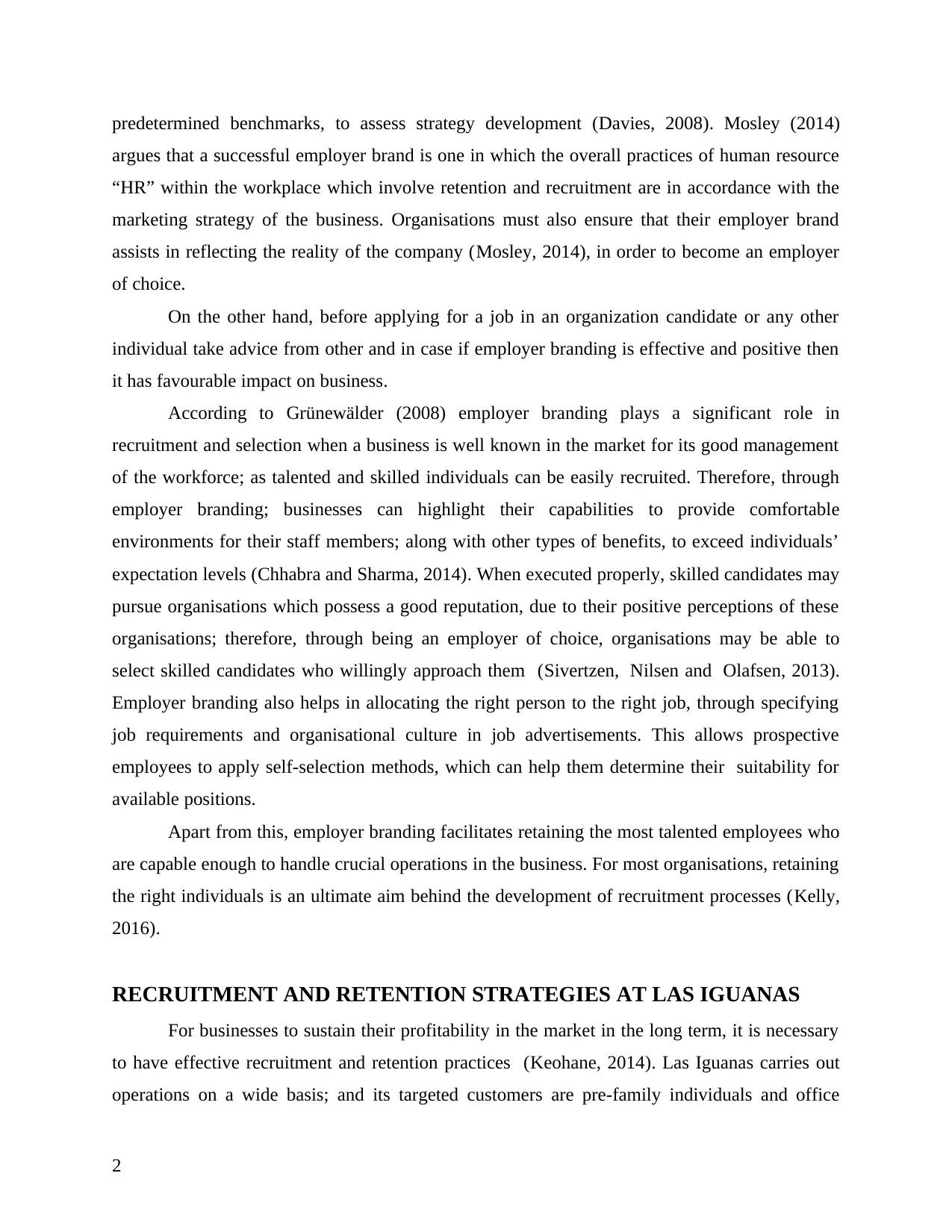
predetermined benchmarks, to assess strategy development (Davies, 2008). Mosley (2014)
argues that a successful employer brand is one in which the overall practices of human resource
“HR” within the workplace which involve retention and recruitment are in accordance with the
marketing strategy of the business. Organisations must also ensure that their employer brand
assists in reflecting the reality of the company (Mosley, 2014), in order to become an employer
of choice.
On the other hand, before applying for a job in an organization candidate or any other
individual take advice from other and in case if employer branding is effective and positive then
it has favourable impact on business.
According to Grünewälder (2008) employer branding plays a significant role in
recruitment and selection when a business is well known in the market for its good management
of the workforce; as talented and skilled individuals can be easily recruited. Therefore, through
employer branding; businesses can highlight their capabilities to provide comfortable
environments for their staff members; along with other types of benefits, to exceed individuals’
expectation levels (Chhabra and Sharma, 2014). When executed properly, skilled candidates may
pursue organisations which possess a good reputation, due to their positive perceptions of these
organisations; therefore, through being an employer of choice, organisations may be able to
select skilled candidates who willingly approach them (Sivertzen, Nilsen and Olafsen, 2013).
Employer branding also helps in allocating the right person to the right job, through specifying
job requirements and organisational culture in job advertisements. This allows prospective
employees to apply self-selection methods, which can help them determine their suitability for
available positions.
Apart from this, employer branding facilitates retaining the most talented employees who
are capable enough to handle crucial operations in the business. For most organisations, retaining
the right individuals is an ultimate aim behind the development of recruitment processes (Kelly,
2016).
RECRUITMENT AND RETENTION STRATEGIES AT LAS IGUANAS
For businesses to sustain their profitability in the market in the long term, it is necessary
to have effective recruitment and retention practices (Keohane, 2014). Las Iguanas carries out
operations on a wide basis; and its targeted customers are pre-family individuals and office
2
argues that a successful employer brand is one in which the overall practices of human resource
“HR” within the workplace which involve retention and recruitment are in accordance with the
marketing strategy of the business. Organisations must also ensure that their employer brand
assists in reflecting the reality of the company (Mosley, 2014), in order to become an employer
of choice.
On the other hand, before applying for a job in an organization candidate or any other
individual take advice from other and in case if employer branding is effective and positive then
it has favourable impact on business.
According to Grünewälder (2008) employer branding plays a significant role in
recruitment and selection when a business is well known in the market for its good management
of the workforce; as talented and skilled individuals can be easily recruited. Therefore, through
employer branding; businesses can highlight their capabilities to provide comfortable
environments for their staff members; along with other types of benefits, to exceed individuals’
expectation levels (Chhabra and Sharma, 2014). When executed properly, skilled candidates may
pursue organisations which possess a good reputation, due to their positive perceptions of these
organisations; therefore, through being an employer of choice, organisations may be able to
select skilled candidates who willingly approach them (Sivertzen, Nilsen and Olafsen, 2013).
Employer branding also helps in allocating the right person to the right job, through specifying
job requirements and organisational culture in job advertisements. This allows prospective
employees to apply self-selection methods, which can help them determine their suitability for
available positions.
Apart from this, employer branding facilitates retaining the most talented employees who
are capable enough to handle crucial operations in the business. For most organisations, retaining
the right individuals is an ultimate aim behind the development of recruitment processes (Kelly,
2016).
RECRUITMENT AND RETENTION STRATEGIES AT LAS IGUANAS
For businesses to sustain their profitability in the market in the long term, it is necessary
to have effective recruitment and retention practices (Keohane, 2014). Las Iguanas carries out
operations on a wide basis; and its targeted customers are pre-family individuals and office
2
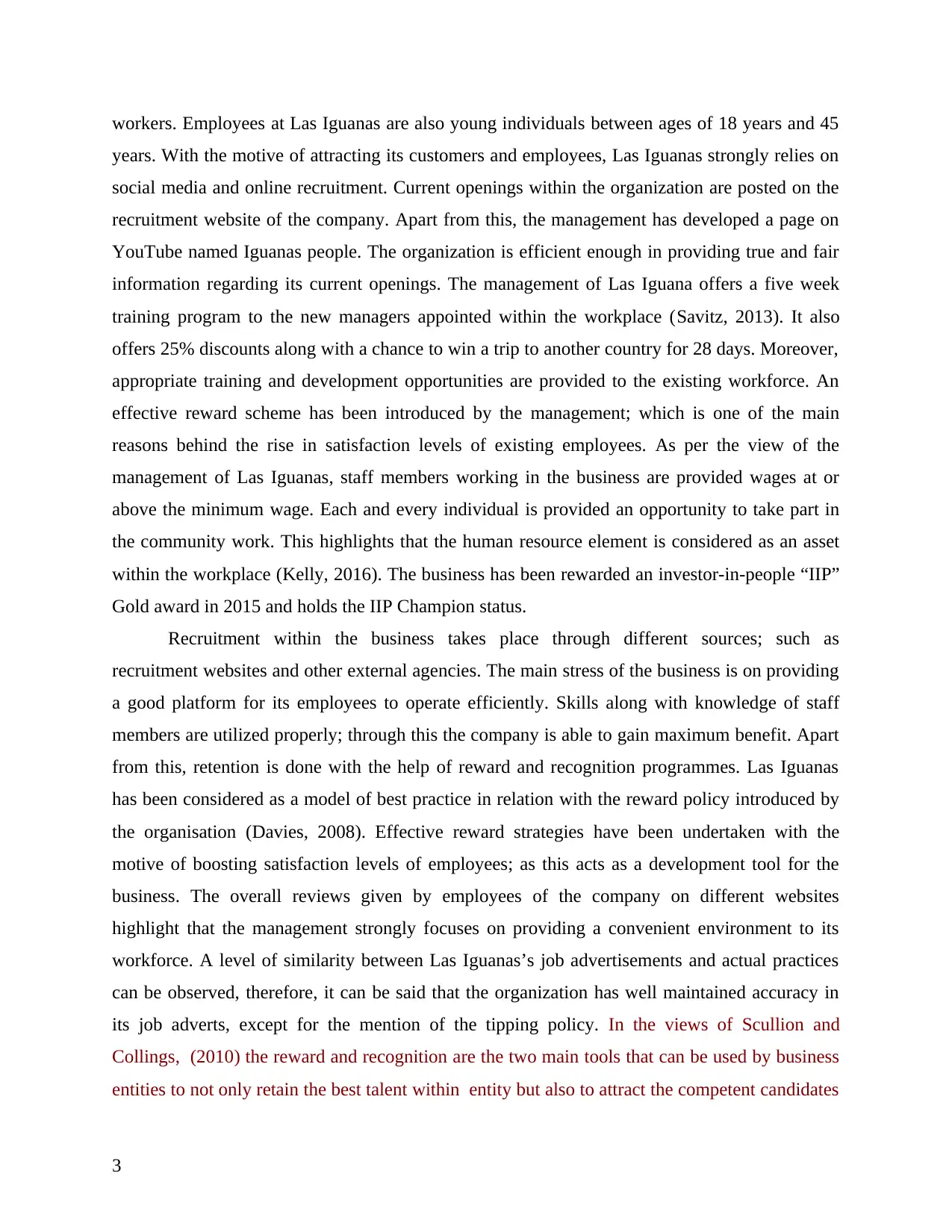
workers. Employees at Las Iguanas are also young individuals between ages of 18 years and 45
years. With the motive of attracting its customers and employees, Las Iguanas strongly relies on
social media and online recruitment. Current openings within the organization are posted on the
recruitment website of the company. Apart from this, the management has developed a page on
YouTube named Iguanas people. The organization is efficient enough in providing true and fair
information regarding its current openings. The management of Las Iguana offers a five week
training program to the new managers appointed within the workplace (Savitz, 2013). It also
offers 25% discounts along with a chance to win a trip to another country for 28 days. Moreover,
appropriate training and development opportunities are provided to the existing workforce. An
effective reward scheme has been introduced by the management; which is one of the main
reasons behind the rise in satisfaction levels of existing employees. As per the view of the
management of Las Iguanas, staff members working in the business are provided wages at or
above the minimum wage. Each and every individual is provided an opportunity to take part in
the community work. This highlights that the human resource element is considered as an asset
within the workplace (Kelly, 2016). The business has been rewarded an investor-in-people “IIP”
Gold award in 2015 and holds the IIP Champion status.
Recruitment within the business takes place through different sources; such as
recruitment websites and other external agencies. The main stress of the business is on providing
a good platform for its employees to operate efficiently. Skills along with knowledge of staff
members are utilized properly; through this the company is able to gain maximum benefit. Apart
from this, retention is done with the help of reward and recognition programmes. Las Iguanas
has been considered as a model of best practice in relation with the reward policy introduced by
the organisation (Davies, 2008). Effective reward strategies have been undertaken with the
motive of boosting satisfaction levels of employees; as this acts as a development tool for the
business. The overall reviews given by employees of the company on different websites
highlight that the management strongly focuses on providing a convenient environment to its
workforce. A level of similarity between Las Iguanas’s job advertisements and actual practices
can be observed, therefore, it can be said that the organization has well maintained accuracy in
its job adverts, except for the mention of the tipping policy. In the views of Scullion and
Collings, (2010) the reward and recognition are the two main tools that can be used by business
entities to not only retain the best talent within entity but also to attract the competent candidates
3
years. With the motive of attracting its customers and employees, Las Iguanas strongly relies on
social media and online recruitment. Current openings within the organization are posted on the
recruitment website of the company. Apart from this, the management has developed a page on
YouTube named Iguanas people. The organization is efficient enough in providing true and fair
information regarding its current openings. The management of Las Iguana offers a five week
training program to the new managers appointed within the workplace (Savitz, 2013). It also
offers 25% discounts along with a chance to win a trip to another country for 28 days. Moreover,
appropriate training and development opportunities are provided to the existing workforce. An
effective reward scheme has been introduced by the management; which is one of the main
reasons behind the rise in satisfaction levels of existing employees. As per the view of the
management of Las Iguanas, staff members working in the business are provided wages at or
above the minimum wage. Each and every individual is provided an opportunity to take part in
the community work. This highlights that the human resource element is considered as an asset
within the workplace (Kelly, 2016). The business has been rewarded an investor-in-people “IIP”
Gold award in 2015 and holds the IIP Champion status.
Recruitment within the business takes place through different sources; such as
recruitment websites and other external agencies. The main stress of the business is on providing
a good platform for its employees to operate efficiently. Skills along with knowledge of staff
members are utilized properly; through this the company is able to gain maximum benefit. Apart
from this, retention is done with the help of reward and recognition programmes. Las Iguanas
has been considered as a model of best practice in relation with the reward policy introduced by
the organisation (Davies, 2008). Effective reward strategies have been undertaken with the
motive of boosting satisfaction levels of employees; as this acts as a development tool for the
business. The overall reviews given by employees of the company on different websites
highlight that the management strongly focuses on providing a convenient environment to its
workforce. A level of similarity between Las Iguanas’s job advertisements and actual practices
can be observed, therefore, it can be said that the organization has well maintained accuracy in
its job adverts, except for the mention of the tipping policy. In the views of Scullion and
Collings, (2010) the reward and recognition are the two main tools that can be used by business
entities to not only retain the best talent within entity but also to attract the competent candidates
3
⊘ This is a preview!⊘
Do you want full access?
Subscribe today to unlock all pages.

Trusted by 1+ million students worldwide
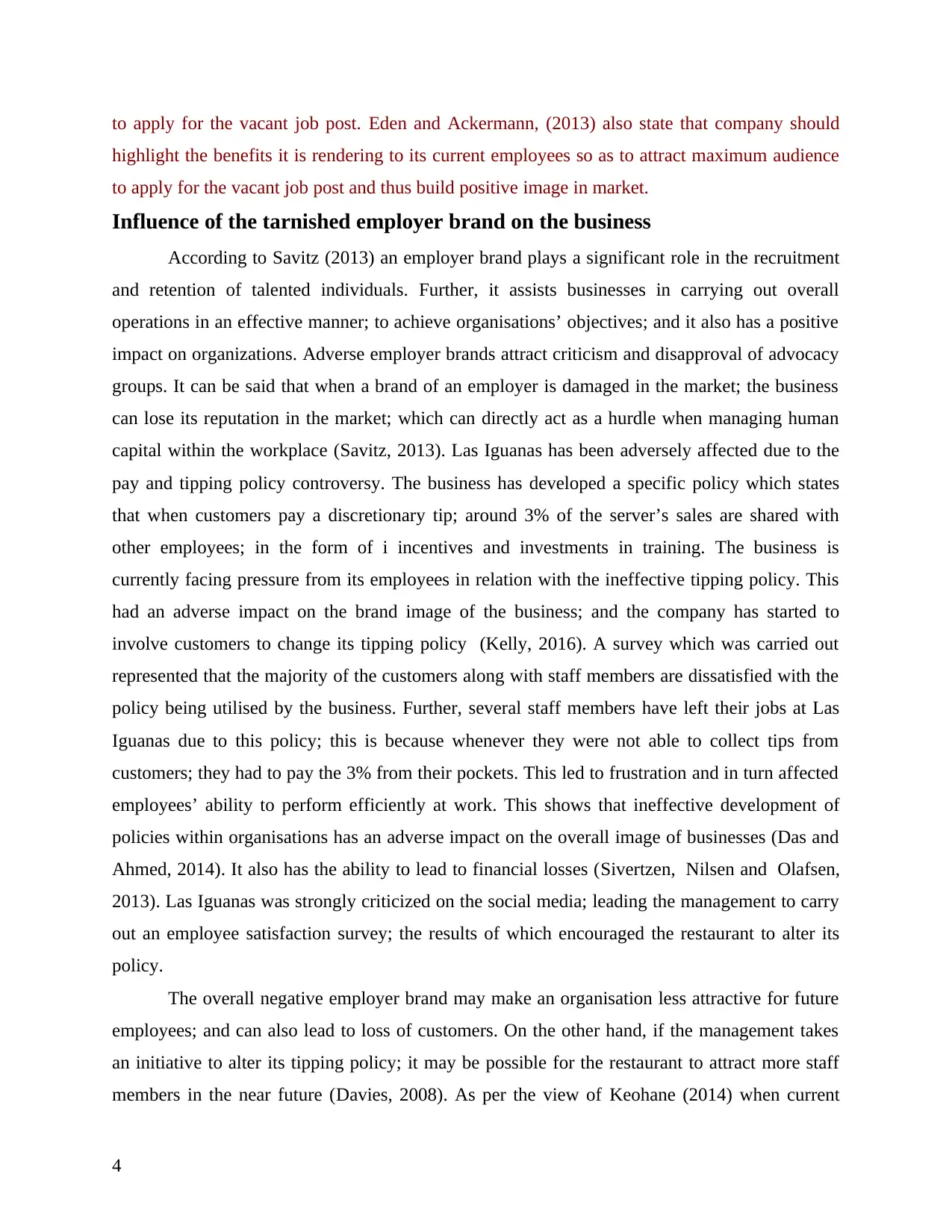
to apply for the vacant job post. Eden and Ackermann, (2013) also state that company should
highlight the benefits it is rendering to its current employees so as to attract maximum audience
to apply for the vacant job post and thus build positive image in market.
Influence of the tarnished employer brand on the business
According to Savitz (2013) an employer brand plays a significant role in the recruitment
and retention of talented individuals. Further, it assists businesses in carrying out overall
operations in an effective manner; to achieve organisations’ objectives; and it also has a positive
impact on organizations. Adverse employer brands attract criticism and disapproval of advocacy
groups. It can be said that when a brand of an employer is damaged in the market; the business
can lose its reputation in the market; which can directly act as a hurdle when managing human
capital within the workplace (Savitz, 2013). Las Iguanas has been adversely affected due to the
pay and tipping policy controversy. The business has developed a specific policy which states
that when customers pay a discretionary tip; around 3% of the server’s sales are shared with
other employees; in the form of i incentives and investments in training. The business is
currently facing pressure from its employees in relation with the ineffective tipping policy. This
had an adverse impact on the brand image of the business; and the company has started to
involve customers to change its tipping policy (Kelly, 2016). A survey which was carried out
represented that the majority of the customers along with staff members are dissatisfied with the
policy being utilised by the business. Further, several staff members have left their jobs at Las
Iguanas due to this policy; this is because whenever they were not able to collect tips from
customers; they had to pay the 3% from their pockets. This led to frustration and in turn affected
employees’ ability to perform efficiently at work. This shows that ineffective development of
policies within organisations has an adverse impact on the overall image of businesses (Das and
Ahmed, 2014). It also has the ability to lead to financial losses (Sivertzen, Nilsen and Olafsen,
2013). Las Iguanas was strongly criticized on the social media; leading the management to carry
out an employee satisfaction survey; the results of which encouraged the restaurant to alter its
policy.
The overall negative employer brand may make an organisation less attractive for future
employees; and can also lead to loss of customers. On the other hand, if the management takes
an initiative to alter its tipping policy; it may be possible for the restaurant to attract more staff
members in the near future (Davies, 2008). As per the view of Keohane (2014) when current
4
highlight the benefits it is rendering to its current employees so as to attract maximum audience
to apply for the vacant job post and thus build positive image in market.
Influence of the tarnished employer brand on the business
According to Savitz (2013) an employer brand plays a significant role in the recruitment
and retention of talented individuals. Further, it assists businesses in carrying out overall
operations in an effective manner; to achieve organisations’ objectives; and it also has a positive
impact on organizations. Adverse employer brands attract criticism and disapproval of advocacy
groups. It can be said that when a brand of an employer is damaged in the market; the business
can lose its reputation in the market; which can directly act as a hurdle when managing human
capital within the workplace (Savitz, 2013). Las Iguanas has been adversely affected due to the
pay and tipping policy controversy. The business has developed a specific policy which states
that when customers pay a discretionary tip; around 3% of the server’s sales are shared with
other employees; in the form of i incentives and investments in training. The business is
currently facing pressure from its employees in relation with the ineffective tipping policy. This
had an adverse impact on the brand image of the business; and the company has started to
involve customers to change its tipping policy (Kelly, 2016). A survey which was carried out
represented that the majority of the customers along with staff members are dissatisfied with the
policy being utilised by the business. Further, several staff members have left their jobs at Las
Iguanas due to this policy; this is because whenever they were not able to collect tips from
customers; they had to pay the 3% from their pockets. This led to frustration and in turn affected
employees’ ability to perform efficiently at work. This shows that ineffective development of
policies within organisations has an adverse impact on the overall image of businesses (Das and
Ahmed, 2014). It also has the ability to lead to financial losses (Sivertzen, Nilsen and Olafsen,
2013). Las Iguanas was strongly criticized on the social media; leading the management to carry
out an employee satisfaction survey; the results of which encouraged the restaurant to alter its
policy.
The overall negative employer brand may make an organisation less attractive for future
employees; and can also lead to loss of customers. On the other hand, if the management takes
an initiative to alter its tipping policy; it may be possible for the restaurant to attract more staff
members in the near future (Davies, 2008). As per the view of Keohane (2014) when current
4
Paraphrase This Document
Need a fresh take? Get an instant paraphrase of this document with our AI Paraphraser
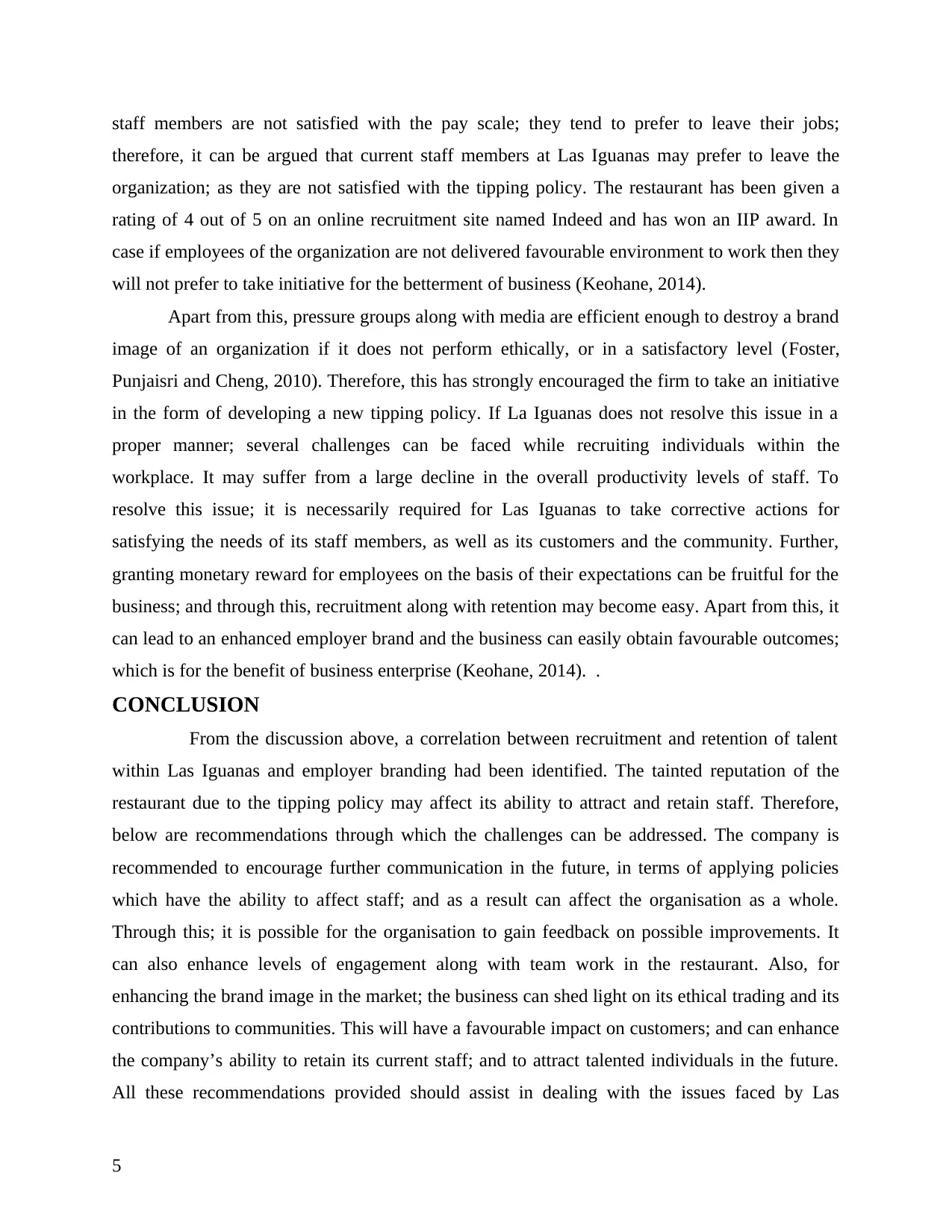
staff members are not satisfied with the pay scale; they tend to prefer to leave their jobs;
therefore, it can be argued that current staff members at Las Iguanas may prefer to leave the
organization; as they are not satisfied with the tipping policy. The restaurant has been given a
rating of 4 out of 5 on an online recruitment site named Indeed and has won an IIP award. In
case if employees of the organization are not delivered favourable environment to work then they
will not prefer to take initiative for the betterment of business (Keohane, 2014).
Apart from this, pressure groups along with media are efficient enough to destroy a brand
image of an organization if it does not perform ethically, or in a satisfactory level (Foster,
Punjaisri and Cheng, 2010). Therefore, this has strongly encouraged the firm to take an initiative
in the form of developing a new tipping policy. If La Iguanas does not resolve this issue in a
proper manner; several challenges can be faced while recruiting individuals within the
workplace. It may suffer from a large decline in the overall productivity levels of staff. To
resolve this issue; it is necessarily required for Las Iguanas to take corrective actions for
satisfying the needs of its staff members, as well as its customers and the community. Further,
granting monetary reward for employees on the basis of their expectations can be fruitful for the
business; and through this, recruitment along with retention may become easy. Apart from this, it
can lead to an enhanced employer brand and the business can easily obtain favourable outcomes;
which is for the benefit of business enterprise (Keohane, 2014). .
CONCLUSION
From the discussion above, a correlation between recruitment and retention of talent
within Las Iguanas and employer branding had been identified. The tainted reputation of the
restaurant due to the tipping policy may affect its ability to attract and retain staff. Therefore,
below are recommendations through which the challenges can be addressed. The company is
recommended to encourage further communication in the future, in terms of applying policies
which have the ability to affect staff; and as a result can affect the organisation as a whole.
Through this; it is possible for the organisation to gain feedback on possible improvements. It
can also enhance levels of engagement along with team work in the restaurant. Also, for
enhancing the brand image in the market; the business can shed light on its ethical trading and its
contributions to communities. This will have a favourable impact on customers; and can enhance
the company’s ability to retain its current staff; and to attract talented individuals in the future.
All these recommendations provided should assist in dealing with the issues faced by Las
5
therefore, it can be argued that current staff members at Las Iguanas may prefer to leave the
organization; as they are not satisfied with the tipping policy. The restaurant has been given a
rating of 4 out of 5 on an online recruitment site named Indeed and has won an IIP award. In
case if employees of the organization are not delivered favourable environment to work then they
will not prefer to take initiative for the betterment of business (Keohane, 2014).
Apart from this, pressure groups along with media are efficient enough to destroy a brand
image of an organization if it does not perform ethically, or in a satisfactory level (Foster,
Punjaisri and Cheng, 2010). Therefore, this has strongly encouraged the firm to take an initiative
in the form of developing a new tipping policy. If La Iguanas does not resolve this issue in a
proper manner; several challenges can be faced while recruiting individuals within the
workplace. It may suffer from a large decline in the overall productivity levels of staff. To
resolve this issue; it is necessarily required for Las Iguanas to take corrective actions for
satisfying the needs of its staff members, as well as its customers and the community. Further,
granting monetary reward for employees on the basis of their expectations can be fruitful for the
business; and through this, recruitment along with retention may become easy. Apart from this, it
can lead to an enhanced employer brand and the business can easily obtain favourable outcomes;
which is for the benefit of business enterprise (Keohane, 2014). .
CONCLUSION
From the discussion above, a correlation between recruitment and retention of talent
within Las Iguanas and employer branding had been identified. The tainted reputation of the
restaurant due to the tipping policy may affect its ability to attract and retain staff. Therefore,
below are recommendations through which the challenges can be addressed. The company is
recommended to encourage further communication in the future, in terms of applying policies
which have the ability to affect staff; and as a result can affect the organisation as a whole.
Through this; it is possible for the organisation to gain feedback on possible improvements. It
can also enhance levels of engagement along with team work in the restaurant. Also, for
enhancing the brand image in the market; the business can shed light on its ethical trading and its
contributions to communities. This will have a favourable impact on customers; and can enhance
the company’s ability to retain its current staff; and to attract talented individuals in the future.
All these recommendations provided should assist in dealing with the issues faced by Las
5
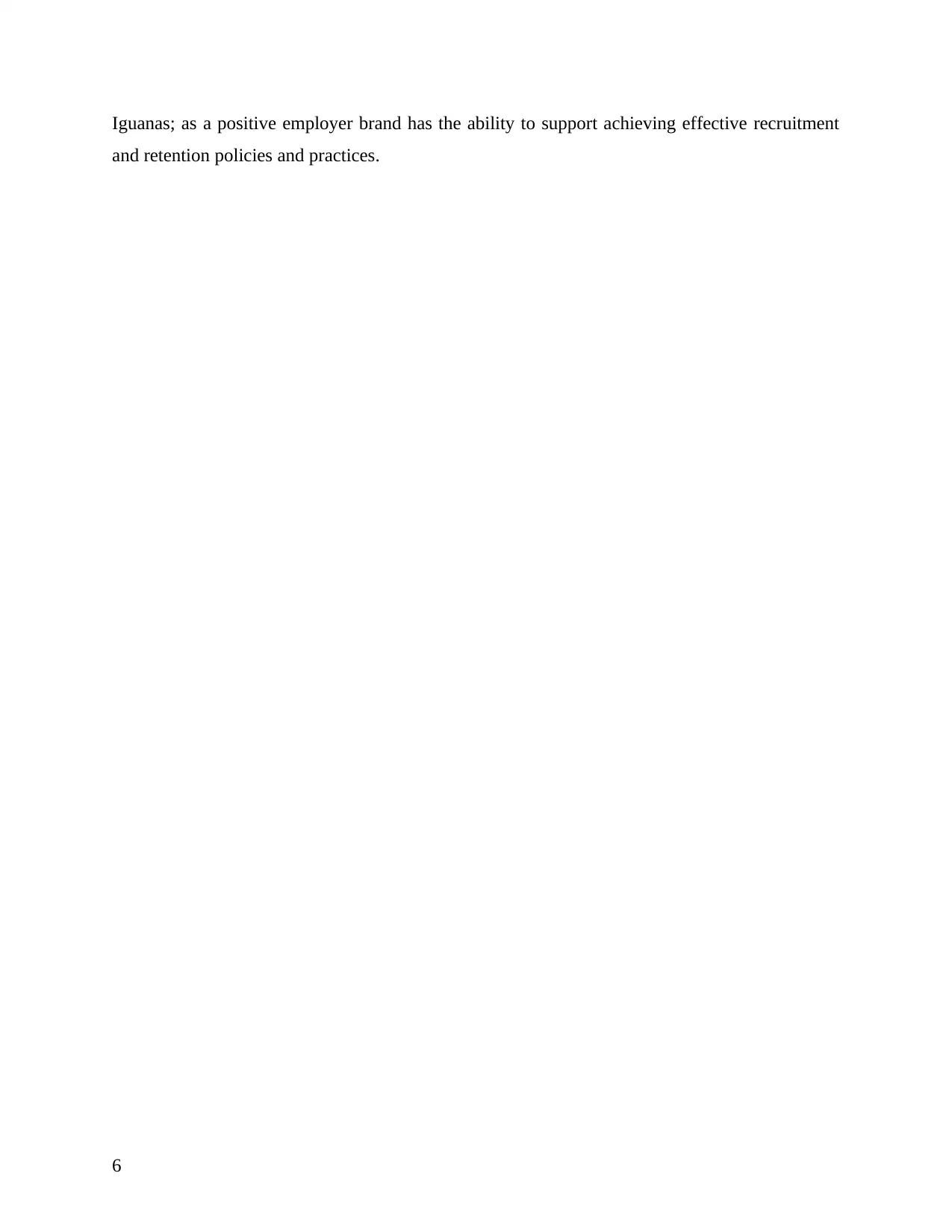
Iguanas; as a positive employer brand has the ability to support achieving effective recruitment
and retention policies and practices.
6
and retention policies and practices.
6
⊘ This is a preview!⊘
Do you want full access?
Subscribe today to unlock all pages.

Trusted by 1+ million students worldwide
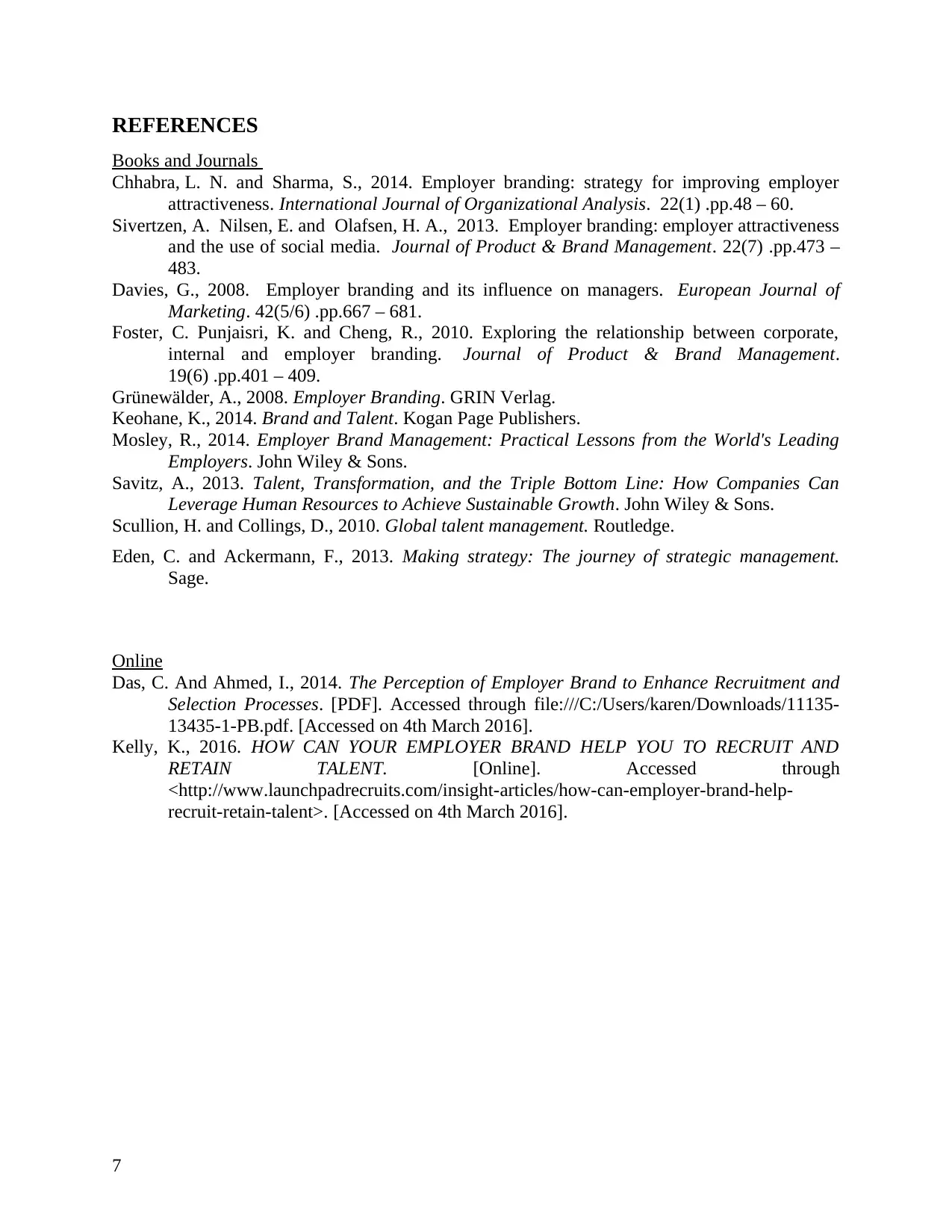
REFERENCES
Books and Journals
Chhabra, L. N. and Sharma, S., 2014. Employer branding: strategy for improving employer
attractiveness. International Journal of Organizational Analysis. 22(1) .pp.48 – 60.
Sivertzen, A. Nilsen, E. and Olafsen, H. A., 2013. Employer branding: employer attractiveness
and the use of social media. Journal of Product & Brand Management. 22(7) .pp.473 –
483.
Davies, G., 2008. Employer branding and its influence on managers. European Journal of
Marketing. 42(5/6) .pp.667 – 681.
Foster, C. Punjaisri, K. and Cheng, R., 2010. Exploring the relationship between corporate,
internal and employer branding. Journal of Product & Brand Management.
19(6) .pp.401 – 409.
Grünewälder, A., 2008. Employer Branding. GRIN Verlag.
Keohane, K., 2014. Brand and Talent. Kogan Page Publishers.
Mosley, R., 2014. Employer Brand Management: Practical Lessons from the World's Leading
Employers. John Wiley & Sons.
Savitz, A., 2013. Talent, Transformation, and the Triple Bottom Line: How Companies Can
Leverage Human Resources to Achieve Sustainable Growth. John Wiley & Sons.
Scullion, H. and Collings, D., 2010. Global talent management. Routledge.
Eden, C. and Ackermann, F., 2013. Making strategy: The journey of strategic management.
Sage.
Online
Das, C. And Ahmed, I., 2014. The Perception of Employer Brand to Enhance Recruitment and
Selection Processes. [PDF]. Accessed through file:///C:/Users/karen/Downloads/11135-
13435-1-PB.pdf. [Accessed on 4th March 2016].
Kelly, K., 2016. HOW CAN YOUR EMPLOYER BRAND HELP YOU TO RECRUIT AND
RETAIN TALENT. [Online]. Accessed through
<http://www.launchpadrecruits.com/insight-articles/how-can-employer-brand-help-
recruit-retain-talent>. [Accessed on 4th March 2016].
7
Books and Journals
Chhabra, L. N. and Sharma, S., 2014. Employer branding: strategy for improving employer
attractiveness. International Journal of Organizational Analysis. 22(1) .pp.48 – 60.
Sivertzen, A. Nilsen, E. and Olafsen, H. A., 2013. Employer branding: employer attractiveness
and the use of social media. Journal of Product & Brand Management. 22(7) .pp.473 –
483.
Davies, G., 2008. Employer branding and its influence on managers. European Journal of
Marketing. 42(5/6) .pp.667 – 681.
Foster, C. Punjaisri, K. and Cheng, R., 2010. Exploring the relationship between corporate,
internal and employer branding. Journal of Product & Brand Management.
19(6) .pp.401 – 409.
Grünewälder, A., 2008. Employer Branding. GRIN Verlag.
Keohane, K., 2014. Brand and Talent. Kogan Page Publishers.
Mosley, R., 2014. Employer Brand Management: Practical Lessons from the World's Leading
Employers. John Wiley & Sons.
Savitz, A., 2013. Talent, Transformation, and the Triple Bottom Line: How Companies Can
Leverage Human Resources to Achieve Sustainable Growth. John Wiley & Sons.
Scullion, H. and Collings, D., 2010. Global talent management. Routledge.
Eden, C. and Ackermann, F., 2013. Making strategy: The journey of strategic management.
Sage.
Online
Das, C. And Ahmed, I., 2014. The Perception of Employer Brand to Enhance Recruitment and
Selection Processes. [PDF]. Accessed through file:///C:/Users/karen/Downloads/11135-
13435-1-PB.pdf. [Accessed on 4th March 2016].
Kelly, K., 2016. HOW CAN YOUR EMPLOYER BRAND HELP YOU TO RECRUIT AND
RETAIN TALENT. [Online]. Accessed through
<http://www.launchpadrecruits.com/insight-articles/how-can-employer-brand-help-
recruit-retain-talent>. [Accessed on 4th March 2016].
7
1 out of 7
Related Documents
Your All-in-One AI-Powered Toolkit for Academic Success.
+13062052269
info@desklib.com
Available 24*7 on WhatsApp / Email
![[object Object]](/_next/static/media/star-bottom.7253800d.svg)
Unlock your academic potential
Copyright © 2020–2025 A2Z Services. All Rights Reserved. Developed and managed by ZUCOL.





